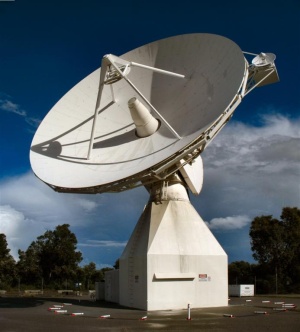Stricken space probe Phobos-Grunt sends more data

The European Space Agency has managed to make contact with Russia's failed Phobos-Grunt space probe on two consecutive nights, the agency said on Thursday.

An ESA antenna in Perth, Australia has been able to communicate with the malfunctioning Phobos-Grunt Mars probe. Photo credit: ESA
The first successful attempt to contact the probe was made on Tuesday night and, on Wednesday night, further telemetric data was received. This data should tell Russian mission controllers about the health of Phobos-Grunt's systems, and perhaps reveal why it is in an unplanned orbit around Earth, rather than travelling to the Martian moon Phobos as intended.
"The spacecraft's radio downlink was commanded to switch on and telemetry was received," European Space Agency (ESA) service manager for Phobos-Grunt, Wolfgang Hell, said in a statement. "The signals received from Phobos-Grunt were much stronger than those initially received on 22 November, in part due to having better knowledge of the spacecraft's orbital position."
Phobos-Grunt, the primary mission of which was to collect a soil sample from Phobos, was launched on 8 November from the Baikonur Cosmodrome in Kazakhstan. Once in low-Earth orbit, the Fregat engine that was supposed to boost the probe onto its interplanetary mission failed, and contact with Phobos-Grunt was lost.
At that point, the Russian space agency Roscosmos asked for the ESA's help in getting back in touch with the probe. The ESA obliged, but initially had no success as no one was sure precisely where Phobos-Grunt was.
Feedhorn antenna
This week, however, someone had the idea of hooking up a feedhorn
antenna to the ESA's 15m-diameter antenna near Perth in
Australia. The location made sense as the satellite's solar panels
would be lit up by the sun while over Australia. Feedhorn antennas can
transmit low-powered signals over wide areas — as Phobos-Grunt
is supposed to communicate from deep space, it is optimised for weak
signals. The standard antenna for tracking and deep-space communication is the dish, which has a very tight focus and needs to point accurately.
Experts had the idea of hooking up a feedhorn antenna to the ESA's tracking station near Perth in Australia. Photo credit: ESA
On Tuesday night — or day in Australia — the ESA team managed to signal the probe with Russian commands, telling it to turn on its own transmitter. It did so, and the first two-way communication took place. Data was returned to the ESA's Space Operations Centre in Darmstadt, Germany.
According to the ESA, the first two of five communications attempts on Wednesday night were also successful. The second of these passes was very brief, only allowing the ESA to send commands to Phobos-Grunt. In the next three passes, no signal was received back.
"Working with Russian mission controllers, ESA engineers are carefully studying the situation, which may be related to the spacecraft's communication system," the ESA said. "During last night's first two passes, one of the two low-gain antennas on Phobos-Grunt was, due to the spacecraft's orbital position, oriented toward Perth, and communications worked."
Troubleshooting
Manfred Warhaut, the ESA's head of mission operations, said the Russians would use the telemetry received on Wednesday night for "troubleshooting" and to figure out what commands the ESA should fire off from Perth on Thursday night.
However, Russian state news outlet RIA reported on Thursday that the telemetry received on Wednesday night was indecipherable.
"It was impossible to get anything out of the telemetry received this morning — there are encoding/decoding problems," a source within the space industry was quoted as saying. The source added that the Perth station would try to extract unencoded data from the probe on Thursday night.
At this point, the scientists are trying to figure out what went wrong so they can stop it happening again next time. According to the RIA report, the window of opportunity for Phobos-Grunt to set off for Mars has now closed, and the mission is a failure.
Get the latest technology news and analysis, blogs and reviewsdelivered directly to your inbox with ="http:>ZDNet UK'snewsletters.